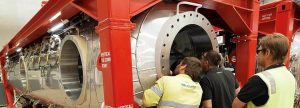
The Royal Australian Navy (RAN) and the Australian Government have granted the licence to operate new $A19.7 million (£11.05 m) hyperbaric equipment which means that for the first time, the whole crew of an Australian submarine can be treated at once.
The equipment – a transfer under pressure chamber and recompression treatment suite – was received from JFD, the world’s leading company in submarine rescue and part of James Fisher and Sons plc as part of an existing Escape and Rescue contract at its advanced manufacturing headquarters at Bibra Lake, south of Perth.
“Achieving acceptance and global certification from Lloyds Register is a very rigorous and demanding procedure” said General Manager JFD Australia, Toff Idrus (himself, a former submariner).
“And what it means for submariners is extremely significant as up tinno 86 people can now receive life-saving medical treatment in the hyperbaric equipment suite and pressurised transfer chamber at any one time.
“When you consider that a Collins-class submarine has a crew of 48 – 60, this new capability is very significant and represents an important milestone for submarine rescue in Australia.”
The hyperbaric equipment suite is able to withstand and operate effectively in rough, continuous seas with swells of 5 metres – conditions not uncommon around the Australian coast.
This capability is critically important as the new kit is the final step in a submarine rescue which begins with rescuing the crew from a disabled submarine and transferring them safely into a JFD free-swimming, piloted rescue vehicle which carries them safely to the surface and on to the deck of a rescue ship.
From here, the submariners are moved through the transfer under pressure chamber and into the hyperbaric equipment suite with doctors monitoriong their wellbeing and helping them overcome any life-threatening effects that come from being rescued from pressurised waters.
“Emergencies of this type rely on highly-skilled personnel and world-class equipment to bring people who have been under pressure at depth to the safety of the surface and it is critical for Australia’s defence capability and national security, that we are able to do this,” said Mr. Idrus.
“Quite simply, the lives of the men and women of the Australian Defence Force may depend on us and we must ensure they are as safe as possible, even in worst-case scenarios.”
The new equipment took two years to build using JFD’s highly skilled workforce of some 100 personnel who will now conduct further naval testing and evaluation of the new equipment in August, culminating in the annual Black Carillion naval exercises in November 2018.
“JFD Australia has developed world-leading local knowledge and skills in submarine rescue and it has confirmed our reputation as a provider of proven, safe and reliable submarine rescue service to the Australian Government,” said Mr Idrus.
“It’s why JFD is the world’s ‘triple-0 number’ for distressed submarines.”
Importantly, the acceptance of the new system could lead to JFD creating more defence industry jobs in Australia as it opens up opportunities to export similar equipment to other countries in the Asia-Pacific region.
